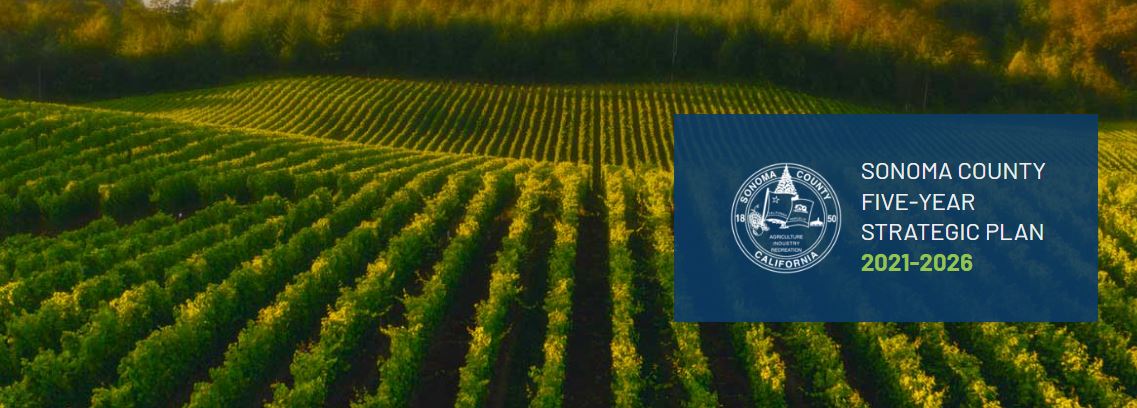Strategic Plan

The Board approved Sonoma County’s Five-Year Strategic Plan in March, 2021 to provide the context to inform policies and projects that are prioritized for the next five years. The Strategic Plan identifies Climate Action and Resiliency as one of its five main pillars. The Climate Action and Resiliency Department (CARD) helps to implement the goals and objectives outlined by this pillar.
These goals and objectives cover a broad range of topics, including energy and grid resilience, greenhouse gas reductions, fleet and building electrification, carbon sequestration, and natural and working land adaptation. The full list of Climate Action and Resiliency (CAR) pillar goals and objectives can be found below. Visit the Strategic Plan Website for more information on CAR pillar implementation or other Strategic Plan pillars.
CAR Goal 1: Continue to invest in wildfire preparedness and resiliency strategies
- Objective 1.1: Provide educational resources to the community that promote and facilitate carbon neutral and fire hardening construction for new and existing homes.
- Objective 1.2: Expand outreach and education on vegetation management and provide additional resources to landowners to help mitigate fire risk.
- Objective 1.3: Leverage grant funding to support sustainable vegetation management program.
CAR Goal 2: Invest in the community to enhance resiliency and become carbon neutral by 2030
- Objective 2.1: Support carbon eliminating microgrid technology in communities and energy grid resilience to reduce impact of power loss during power shutdowns and natural disasters (floors, fires, earthquakes) through education and legislative advocacy, prioritizing critical infrastructure and vulnerable populations.
- Objective 2.2: Provide $20 million in financing by 2026 that incentivizes property managers and renters to retrofit existing multi-family housing towards achieving carbon neutral buildings.
- Objective 2.3: Partner with educational institutions, trade organizations, businesses, and non-profit organizations to establish workforce development programs that focus on carbon neutral and resilient building technologies by 2023.
CAR Goal 3: Make all County facilities carbon free, zero waste, and resilient
- Objective 3.1: Design or retrofit County facilities to be carbon neutral, zero waste, and incorporate resilient construction techniques and materials.
- Objective 3.2: Design or retrofit County facilities that promote and maximize telework to decrease greenhouse gas emissions generated by employee commutes.
- Objective 3.3: Invest in County owned facilities, establishing carbon eliminating microgrid technology and improving energy grid resilience to reduce the impact of power loss during power shutdowns and natural disasters (floors, fires, earthquakes), prioritizing critical infrastructure such as command and communications facilities.
CAR Goal 4: Maximize sustainability and emissions reductions in all County fleet vehicles
- Objective 4.1: Where feasible, phase out County (owned or leased) gasoline powered light-duty cars, vans, and pick-ups to achieve a 30% zero-emission vehicle light-duty fleet by 2026.
- Objective 4.2: Invest in the County’s employee Clean Commute program to promote use of alternate modes of transportation, including bike and carpool incentives, and last mile solutions connecting bus and train stations to County worksites.
- Objective 4.3: Upgrade the existing County owned Electric Vehicle charging station infrastructure by 2023.
CAR Goal 5: Maximize opportunities for mitigation of climate change and adaptation through land conversation work and land use policies
- Objective 5.1: By 2025, update the County General Plan and other county/special district planning documents to incorporate policy language and identify areas within the County that have the potential to maximize carbon sequestration and provide opportunities for climate change adaptation. The focus of these actions will be to increase overall landscape and species resiliency, reduce the risk of fire and floods, and address sea level rise and biodiversity loss.
- Objective 5.2: Develop policies to maximize carbon sequestration and minimize loss of natural carbon sinks including old growth forests, the Laguna de Santa Rosa, and rangelands. Encourage agricultural and open space land management to maximize sequestration. Develop a framework and policies to incentivize collaboration with private and public landowners.